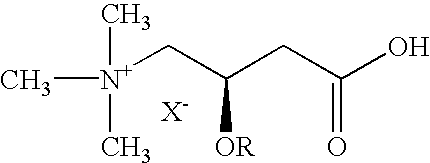Method for preventing and/or treating peripheral neuropathies induced by the administration of an anticancer agent
a technology of anticancer agent and peripheral neuropathy, which is applied in the direction of biocide, drug composition, peptide/protein ingredients, etc., can solve the problems of reducing the dose of the agent, affecting the survival of patients, and a large number of toxic or side effects
- Summary
- Abstract
- Description
- Claims
- Application Information
AI Technical Summary
Benefits of technology
Problems solved by technology
Method used
Image
Examples
example 2
[0095] Protective Effect of Acetyl L-carnitine on an Experimental Model of Taxol-induced Peripheral Neuropathy--Prevention Treatment.
[0096] The purpose of this study is to demonstrate and evaluate the protective properties, by way of prevention, of acetyl L-carnitine administered one week prior to Taxol at two different doses of the latter (16 mg / kg and 8 mg / kg), by measuring the sensory nerve conduction velocity (SNCV), determined on the tail.
[0097] Female Wistar rats aged 3 months (Charles River) were used, housed at 22.+-.2.degree. C., with 50.+-.15% relative humidity and a 12 hour light / darkness cycle.
[0098] The rats were identified immediately prior to treatment by means of progressive numbers on their tails and were maintained with water and feed "ad libitum".
[0099] The substances used were acetyl L-carnitine and Taxol.
[0100] The following experimental groups were formed:
[0101] 1. Controls.
[0102] 2. Sham (group receiving Taxol solution solvent).
[0103] 3. Taxol 16 mg / kg.
[0104] ...
example 3
[0119] Protective effect of acetyl L-carnitine on Taxol-induced weight loss.
[0120] The animals used in the preceding experimental model were weighed prior to starting treatment (basal values) and at the end of treatment.
[0121] The data given in Table 3 here below demonstrate the substantial and unexpected protective effect exerted by acetyl L-carnitine on loss of body weight caused by Taxol 16 mg / kg treatment.
3TABLE 3 Body weight of animals treated with Taxol alone or in combination with acetyl L-carnitine. MEASUREMENTS % TREATMENT BASAL 5 WEEKS % vs BASAL vs SHAM Control 209 .+-. 9.1 250 .+-. 12.4 +20*** (6) (6) Sham 205 .+-. 12.2 234 .+-. 12.8 +14*** (8) (8) Taxol 210 .+-. 9.1 237 .+-. 20.8 +13** +1 8 mg / kg (8) (8) Taxol 212 .+-. 12.5 180 .+-. 16.0 -15** -23.cndot. 16 mg / kg (6) (6) ALC + Taxol 207 .+-. 6.7 228 .+-. 20.5 +10* -2 8 mg / kg (8) (8) ALC + Taxol 210 .+-. 6.5 216 .+-. 37.6 +3 -8 16 mg (6) (6) Values are means .+-. standard deviation. In brackets the number of animals used...
example 4
[0122] Protective Effect of Acetyl L-carnitine on an Experimental Model of Taxol-induced Peripheral Neuropathy--Therapeutic Treatment.
[0123] The purpose of this study is to demonstrate and evaluate the protective properties, by way of treatment, of acetyl L-carnitine.
[0124] Peripheral neuropathy was induced by two Taxol cycles (2.7 mg / kg / 1.5 ml once a day for 5 days), 6 days apart.
[0125] Acetyl L-carnitine was administered subcutaneously, during the follow-up period (recovery). The dose of 100 mg / Kg / day was administered on the basis of individual body weight. Sham (NaCl 0.9%), Vehicle (Cremophor.RTM.-ethanol 1:1) and Taxol-treated animals were treated with the vehicle.
[0126] Nerve conduction velocity (NCV) was measured in each animal prior to start of treatment (basal), two days after the last administration of Taxol (Taxol) and weekly thereafter (recovery).
[0127] NCV was determined as in Example 2.
[0128] After the last NCV recording, the animals were sacrificed under anaesthesia an...
PUM
| Property | Measurement | Unit |
|---|---|---|
| body weight | aaaaa | aaaaa |
| size | aaaaa | aaaaa |
| volume | aaaaa | aaaaa |
Abstract
Description
Claims
Application Information
 Login to View More
Login to View More - R&D
- Intellectual Property
- Life Sciences
- Materials
- Tech Scout
- Unparalleled Data Quality
- Higher Quality Content
- 60% Fewer Hallucinations
Browse by: Latest US Patents, China's latest patents, Technical Efficacy Thesaurus, Application Domain, Technology Topic, Popular Technical Reports.
© 2025 PatSnap. All rights reserved.Legal|Privacy policy|Modern Slavery Act Transparency Statement|Sitemap|About US| Contact US: help@patsnap.com



